Interview with Sam Lightner, Jr.
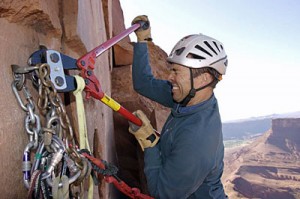 A friend and I recently replaced several anchors on Independence Pass, thanks to some gear from the American Safe Climbing Association (ASCA). One bolt was particularly terrifying, and it felt good to upgrade some popular routes so that folks can continue to safely enjoy them for many years to come. The work was time consuming, and it got me thinking about a guy I met, through a mutual friend, who has replaced an incredible amount of crappy anchors. In fact, if you’ve spent any time climbing around Moab, chances are you’ve lowered or rappelled off an anchor that was replaced by Sam Lightner, Jr. He and his crew have been tirelessly at work, upgrading the old mank scattered across the desert, from Castleton to Wall Street. I recently caught up with him to find out more about what he’s been up to, how he got into it, and what else he enjoys in the desert.
A friend and I recently replaced several anchors on Independence Pass, thanks to some gear from the American Safe Climbing Association (ASCA). One bolt was particularly terrifying, and it felt good to upgrade some popular routes so that folks can continue to safely enjoy them for many years to come. The work was time consuming, and it got me thinking about a guy I met, through a mutual friend, who has replaced an incredible amount of crappy anchors. In fact, if you’ve spent any time climbing around Moab, chances are you’ve lowered or rappelled off an anchor that was replaced by Sam Lightner, Jr. He and his crew have been tirelessly at work, upgrading the old mank scattered across the desert, from Castleton to Wall Street. I recently caught up with him to find out more about what he’s been up to, how he got into it, and what else he enjoys in the desert.
It seems your name has become synonymous with anchor replacement in the Moab area, how long have you been replacing anchors for?
I actually did my first anchor replacement at Vedauwoo in like 1987. That was on Fall Wall, the bolts were buttonheads with Leeper hangers from the early 70’s or late 60’s. Since then I guess I have replaced stuff in the Tetons, City of Rocks, areas around Banff, and of course Thailand.
How did you get started?
I just noticed it needed to be done, and did it. I think that’s how any act of philanthropy gets started. In the desert I can usually count on the fact that the anchors need some updating. Even people adding bolts to anchors are usually not using ½ inch stainless and chain (instead of webbing). Thailand was a big deal to get going, the scale of what needed to be done required getting a lot of other climbers involved. The desert is pretty simple, but it’s grunt work. You do have to lug the steel a long ways.
Where does the hardware come from? ASCA? ARI?
I’ve been working with Chris MacNamara and Greg Barnes at the ASCA. They started doing this a long time ago in Yosemite and have since branched all over the place. They handle most of the donations going to Thailand as well. I generally buy the chain and links myself, and get the stainless bolts and the hangers from the ASCA.
What are some of the most memorable/worst anchors you’ve replaced?
I’ve had a number of desert anchors pull out with my hands. The banged in angles are kinda funny. Sometimes they look bad and are hard as hell to get out, then other times the pin is deep in what appears to be a perfect hole and they pop out with one yank. They always make a ringing sound if you tap them. Old desert hands often carry hammers so they can tap the pins, if they hear a ring they assume its solid. But the ring happens on the worst of pins too. I think this is because the iron rusts pretty fast on the pin. The rust and sand make a weak bond to the rock… its enough to give it that ring, but not enough to hold us.
It’s a funny thing, sometimes the bolts and pins are solid, but other times they are really bad… usually they are pretty bad. You can’t tell until you begin to yank them. Since I am generally using longer lasting and beefier stuff than was originally there, I just replace almost everything I come across (when I’m carrying the gear).
Were there any that came out so easily it made you sick that people were using them?
It’s actually pretty amazing that many of the anchors in Arches were holding. The top of Zenyatta Entrada was a joke… they just came right out. Most people think the Fishers are the worst rock, but that bad stuff is just on the surface, under it there is often good stone. But the Entrada is usually really soft. In Wingate, I once had a 5 piece Rawl bolt pull out with one yank. That was on The Cauldrons in Hell Roaring Canyon. It was a 3/8″ too. Everything in the desert really needs to be half inch or bigger.
In Thailand, I’ve broken a number of bolts. On one route I clipped a draw to the anchor and then leaned off it to talk to the belayer… it snapped. Your approach to sport climbing changes after you break a bolt, you never really completely trust them again.
You’ve replaced anchors on 69 desert towers, that’s a ton of crap to haul up with you. Did you hire a small army to help you get all that stuff to the base of those routes?
Well, if I was climbing with a partner I often gave them more of the gear or both ropes. However, for the most part, I try to be the one to carry the bolts and chains and drill. I realize this is my thing and I really don’t’ want to force it down anyone else’s throat. That said, most friends like that I’m doing it and ask what they can do to help… sometimes they change their minds when they feel the weight though.
Speaking of towers, I heard you recently climbed your 100th desert tower, that’s a pretty big milestone that most people never even dream of reaching. When did you start climbing towers?
I first went to Indian Creek in 1987, but I didn’t get into the tower thing for at least another 10 years. Some time in the late 90’s I did Moses as my first.
Most folks are happy to repeat the handful of well traveled routes out there, why keep going all the way to 100?
My approach to climbing has been composed of a series of objectives. Certain crack routes in the 80’s, then a series of grades in sport climbing through the 90’s, various ice climbs that I saw as showing improvement, and in the desert I just focused on 100 towers. It was just a way for me to have an objective and feel like I was progressing in climbing. If you climb 100 towers, you probably know how to deal with soft rock pretty well, and that was the progression.
There are probably twenty or so people who have done 100 towers now, and they all have their own idea of what actually is a tower. Crusher Bartlett and I consider it a 5th class or aid class to an obvious summit on the Colorado plateau. My idea of an “obvious summit” is a bit like defining porn… you can’t always describe it perfectly, but you know it when you see it. For me, buttes, like The Rectory, count as towers. Brad Brandewie however keeps his list super strict… he won’t count it unless it’s a tiny summit. No buttes.
What were some of your favorites?
I’d have to say Moses was cool, as was Zeus… Zeus has great climbing that keeps you focused all the way to a tiny summit. I did a bunch of them solo and that always makes them memorable. You get lots of time to think when you solo climb. I really enjoyed soloing the Kingfisher and the Organ, but the best were probably Echo Pinnacle and Aeolean Tower in the Tusher Canyon area. They stand out for the silence of the desert and the feeling of being alone, not the actual movement over rock.
What were the worst/least favorites? Scariest?
Aimee Barnes and I attempted to do The Witch a few years ago. I fell and yanked four pieces out of what appeared to be a very solid crack. It was a big fall and I broke my ankle, tore up some cartilage too. We approached from lower Hell Roaring Canyon, so I then had to hike out on the ankle. That wasn’t much fun. I went back and did the route earlier this year with Josh Gross and it is a great tower… just a scary way to get started with it.
I dropped my drill off Disappearing Angel… shattered it. I guess the thing just came unclipped. That was a sucky day.
But the worst tower… I”d have to say this thing Josh and I did in Day Canyon. I think we called it Oobleck. It was a nice summit, but the rock was terrible.
I heard 12 of them were first ascents, any hidden classics that people should go repeat?
Well, no. There are still classics to be had out there, but you gotta get further off the beaten path than I regularly go. I will say this; I was amazed that some of those towers, even if they didn’t have classic climbing on them, had not been ascended. I mean, this most recent one, The Pillbox, is about the most obvious tower in the desert.
The great thing about the new towers is you always get a unique view into one of the most beautiful places in the world. Every one of them provides just a little different angle on things.
You’ve traveled and climbed all over the world, why call Moab home?
I live there for the adventure. Right out my door I can get to remote area’s that few people ever get to see. I got into climbing because it always gave that sense that you were exploring… sometimes the world, sometimes yourself. You can find that real quick in the Utah desert.
Anything else?
I think all climbers need to be aware that we have a coming national disaster with anchors and bolts. For a couple generations we have been using non-stainless steel for our anchors… that’s not good. Everyone doing any new route or rebolting should be putting out the extra cash, and it does cost a lot, for stainless. Twenty years may seem a long time from now, but it comes faster than you expect… it rolls by and one day you are thinking, “Man, I put those bolts in a long time ago… I bet the inside on those threads is pretty rusty.” I can guarantee you it is… and its not safe. We need to start fixing it now. Its not only a problem for our health, but also access: the easiest way for a land manager to deal with dangerous bolts is to just close an area.
Also, if you put routes up in the desert, please use chain and quicklinks rather than webbing. The webbing fades and weakens in the sun real fast and non climbers have begun to complain about it being unsightly. Painted chain hides real well. It costs more, but in the long run you will be more proud of the route you established.
3 Responses to Interview with Sam Lightner, Jr.
Bulldog Creek Dog Walk (IV WI 4+)
Hayden Carpenter and Tom Bohanon recently repeated an obscure ice climb on the south side of Mt Sopris. Given a brief mention in Jack Robert’s ice guide, Bulldog Creek Walk is described as being 100 meters of WI 4. What they found was seven pitches of ice in a remote setting that makes for one […]
Connect with Us






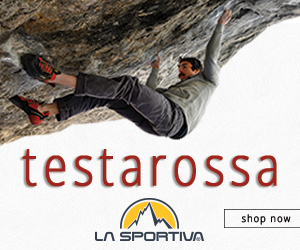

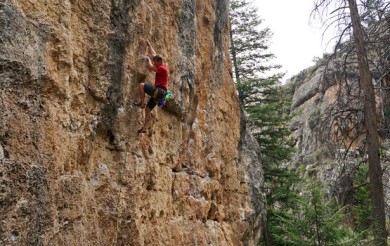
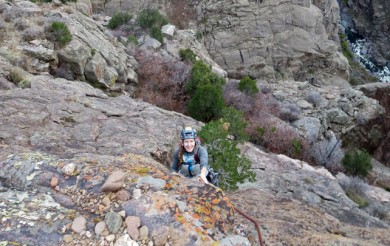
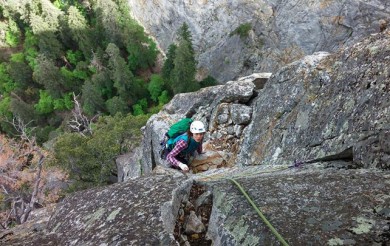
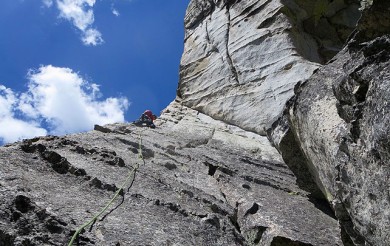



Sam’s the man. I’ve been there to see first-hand the amount of effort and cash he expends keeping us all from hitting the ground.
Buy him a beer if you see him.
Someone buy Sam a cordless grinder. Sheesh dude, retire the boltcutters!
Thank you very much Sam, your work is a great benefit for everybody. I’ve placed quite a lot of cheap bolts when I was a student and had no money. Today I regret it and work only with stainless steel.
As Sam says, put out a littler extra money (you may reduce the number of bolts instead) and using only stainless steel from the beginning is the best for everybody.